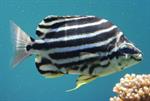
Study Aquarium Management
Whether you want to study this course for work or for a keen interest, it is a thorough and intensive course about looking after fish in aquariums.
It is a great course for anyone wanting to work in commercial aquariums, zoos, aquaculture and marine conservation.
You will learn to create and manage feature aquariums in offices, shopping centres or other commercial locations; or develop skills to work in the Pet Industry.
Lesson Structure
There are 10 lessons in this course:
-
Scope and Nature of Aquaria
-
Aquarium use and management
-
The categories of aquariums
-
Aquariums for fish communities
-
Aquaria Size and Complexity
-
Water quality control
-
Types of Equipment
-
The Water Ecosystem
-
Interactions between organisms and the water environment
-
Checking abiotic factors
-
Different types of natural ecosystems
-
Saltwater ecosystems
-
Freshwater ecosystems
-
Brackish water ecosystems
-
City or Municipal domestic water supplies
-
Rainwater
-
Well or bore water
-
Water quality in the aquarium ecosystem
-
Water treatment options
-
Energy relationships
-
Plants and nutrients
-
Photosynthesis
-
Pollution in an aquarium
-
Nitrogen cycle
-
Overcrowding
-
Overfeeding
-
Water Quality and Management
-
Tank capacity/Tank size
-
Maintaining a Balanced Nitrogen Cycle
-
Aquarium Cycling
-
Changing the Water
-
Vacuuming
-
Algae Removal
-
How to avoid Overfeeding
-
Water Conditions
-
Water Temperature
-
Water Hardness
-
Water pH
-
Salinity
-
Gas Exchange in the Aquarium
-
Preventative Care
-
Moving Your Aquarium Safely
-
Equipment and System Design
-
Learn about the equipment and systems for different aquariums
-
Aquarium Equipment
-
Aquarium Tank
-
Filtration
-
Aeration
-
Light System
-
Aquarium Light Timer (optional)
-
Tank Cover
-
Heaters and Thermometers
-
Gravel
-
Plants and Decorations
-
pH meters
-
Refractometers/Hydrometers
-
Water and Other Additives
-
Adding the Fish
-
Suitable Inhabitants for Your Aquarium
-
Determine appropriate species of animal and plant life to introduce into an aquarium.
-
Freshwater fish types
-
Livebearers
-
Loaches
-
Anabantids
-
Catfish
-
Tetras
-
Cyprinids
-
Rainbow fish
-
Branchiopoda
-
Gastropods
-
Freshwater Aquarium Plants
-
Cold Water Plants
-
Tropical Fresh Water Plants
-
Brackish Water Plants
-
Saltwater Fish Types
-
Saltwater (Marine) Aquarium Plants
-
Fish Health and Diseases
-
Fish Diet
-
Fish Diet Related Problems
-
Vitamin and Mineral Deficiency
-
Origin of Diseases
-
Environmental Diseases
-
Common Signs of an Unhealthy Tank
-
Diseases Caused by Water Quality and Chemistry Problems
-
Water Contamination and Poisoning
-
Ammonia and Nitrate Poisoning
-
Oxygen Starvation - Hypoxia
-
Pathogenic Disease Causes
-
Viral Diseases
-
Bacterial Diseases
-
Fungal Diseases
-
Genetic Diseases and Disorders
-
Parasites
-
Plant Problems
-
Treatment of Diseases and Parasites
-
Quarantine Tank
-
Coral Bleaching
-
Freshwater Tanks
-
How to establish a freshwater tank
-
Tank Selection and Decorations
-
Setting up Tank Décor
-
Setting up Planted Tanks
-
Aqua-scaping
-
Basic Equipment
-
Electricity and Aquarium Set-up
-
Heater Installation
-
Filters and Air Pumps
-
Lighting and Hood
-
Solar Heating
-
Other Equipment
-
Selection and Addition of Fish
-
Feeding Requirements
-
Cleaning and Maintenance
-
Simple Saltwater Tanks
-
How to establish a saltwater tank
-
Tank Selection
-
Saltwater Tank Cycling
-
Filter
-
Basic Equipment for saltwater tanks
-
Heaters and Thermometres
-
Light System
-
Test Kits
-
Selection and Addition of Fish and Other Invertebrates
-
Feeding Requirements
-
Cleaning and Maintenance
-
Critical Parameters Affecting Salinity
-
How concentrations of ions affect salinity
-
How temperature affects salinity
-
Maintenance
-
Learn how to maintain a tank
-
Correct Tank Set-Up and Maintenance
-
Checking the Lighting
-
Checking the Temperature
-
Filter Maintenance
-
Checking and Maintaining Water Quality
-
Fish Observation
-
Plant Maintenance
-
Algae Removal
-
Regular Vacuuming
-
Regular Water Changes
-
Preventative Care
-
Emergencies
-
Breeding
-
Fish Reproduction and Behaviour
-
Live Bearers
-
Egg Layers
-
Breeding
-
Tank Set-up and General Requirements
-
Early Stages - Selecting and Conditioning the Pair
-
Triggering Breeding
-
Hatching the Raising Fry
-
Breeding and Genetics
-
Nutrition
-
Cultivating Your Own Food
-
Fish Legality in Different Countries
-
Aquarium Care
-
Ultraviolet (UV) Sterilisation
-
Cleaning and Maintenance
-
Maintenance of Plants
-
Checking Filters
-
Water Changes
Learn About Different Types of Aquaria
While an aquarium can be used for a number of different purposes,
aquaria are usually divided into different types because each has
specific requirements in terms of water quality, salinity, temperature,
hardware, filtration, lighting, decoration fish selection and other
species. Many new to aquaria may start out with small and very basic
systems with minimal equipment, and easy to care for species, while
developing the skill and knowledge to manage more complex aquatic
systems.
The three main categories of aquariums are:
• Fresh water
• Brackish water (mixture of fresh and sea water)
• Marine or seawater
Would you like to learn about -
- Which aquarium is right for which species?
- The development and upkeep of aquaria?

If your answer is yes, then you can enrol
on the course now, but if you have any questions about the content of
the course or studying with ACS, then please get in touch with us today
- use our FREE COURSE COUNSELLING SERVICE to get in touch with our expert tutors. They will be pleased to help you!
